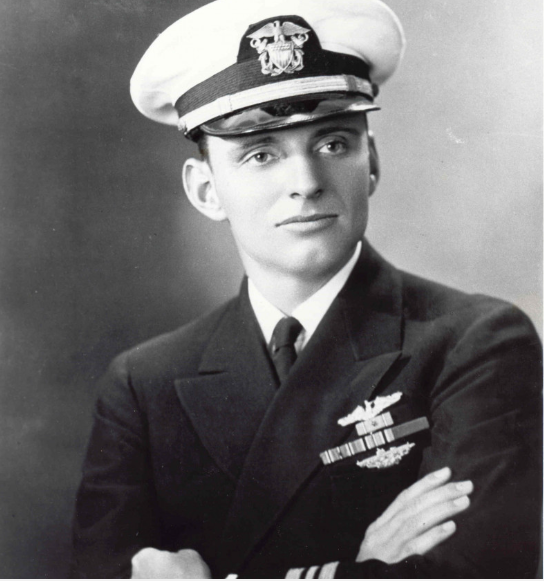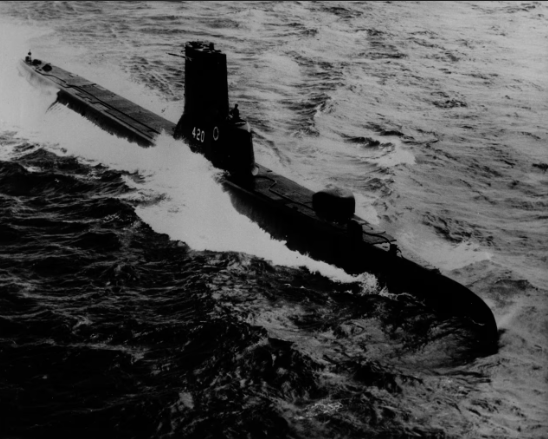
In July 1944, the U.S.S. Tirante submarine commanded by then-Navy Lt. Commander George Levick Street III “sank at least six Japanese ships,” a feat of leadership and bravery that earned Street the Medal of Honor and his crew the Presidential Unit Citation.
The Medal of Honor citation reads:
For conspicuous gallantry and intrepidity at the risk of his life above and beyond the call of duty as commanding officer of the U.S.S. Tirante during the first war patrol of that vessel against enemy Japanese surface forces in the harbor of Quelpart Island, off the coast of Korea on 14 April 1945. With the crew at surface battle stations, Comdr. (then Lt. Comdr.) Street approached the hostile anchorage from the south within 1,200 yards of the coast to complete a reconnoitering circuit of the island. Leaving the 10-fathom curve far behind, he penetrated the mined and shoal-obstructed waters of the restricted harbor despite numerous patrolling vessels and in defiance of five shore-based radar stations and menacing aircraft. Prepared to fight it out on the surface if attacked, Comdr. Street went into action, sending two torpedoes with deadly accuracy into a large Japanese ammunition ship and exploding the target in a mountainous and blinding glare of white flames. With the Tirante instantly spotted by the enemy as she stood out plainly in the flare of light, he ordered the torpedo data computer set up while retiring and fired his last two torpedoes to disintegrate in quick succession the leading frigate and a similar flanking vessel. Clearing the gutted harbor at emergency full speed ahead, he slipped undetected along the shoreline, diving deep as a pursuing patrol dropped a pattern of depth charges at the point of submergence. His illustrious record of combat achievement during the first war patrol of the Tirante characterizes Comdr. Street as a daring and skillful leader and reflects the highest credit upon himself, his valiant command, and the U.S. Naval Service.

Katie Lange at DoD News eloquently expands on the citation:
Before dawn on April 14, 1945, then-Lt. Cmdr. Street and his crew were tasked with doing reconnaissance along the coastline of Quelpart Island off the southwest coast of Korea. Japanese surface forces were docked at the island’s harbor, which was filled with underwater mines and shoals that caused obstructions. Above the water, several surface vessels patrolled. There were also five shore-based radar stations and enemy aircraft patrolling the skies.
Moving into that hostile area undetected was a daunting task, but Street was up for the challenge. As his sub crept into the harbor from the south to within a little more than a half-mile from the coast, the ship’s crew readied itself at surface battle stations in case they were attacked. Then, Street ordered the launch of two torpedoes toward a large Japanese auxiliary transport ship called Juzan Maru. It exploded into a mountainous and blinding glare of white flames, Street’s Medal of Honor citation said.
The flare made the Tirante plainly visible, causing enemy shore batteries to spot it immediately and open fire. Street quickly ordered the ship to turn and run, but as it did so, he fired its last torpedoes at two escort ships that were in aggressive pursuit. Two of the torpedoes hit the ship Nomi, which blew the ship in two. A dud torpedo hit a third ship, called Kaibokan No. 31, but it capsized and sank anyway due to a fire that the torpedo’s strike caused in its after magazine.
Going full speed ahead, Street’s crew managed to clear the debris-filled harbor and slip undetected along the shoreline, where they were able to dive deep and fully get away, even as another enemy ship dropped several depth charges right where they’d begun their dive.
But there is more.
Again, Katie Lange:
Two months after the Quelpart Island incident, Street led the Tirante into another skirmish that earned him the Navy Cross. On June 11, 1945, the sub sank several hostile vessels before moving through treacherously shallow waters into the heart of Nagasaki Harbor, where it sank another enemy ship and destroyed vital docking facilities. Once again, the Tirante managed to escape without being hit by enemy ships or shore gun batteries.
President Harry S. Truman presented the Medal of Honor to then-Commander Street on October 5, 1945, at a White House ceremony.
Lange writes “Street was one of seven World War II submarine commanders to receive the Medal of Honor. He was also the last man from the submarine service to receive it, according to the Naval History and Heritage Command.”
Born on July 27, 1913, in Richmond, Virginia, Street enlisted in the U.S. Naval Reserve after graduating from High School. Subsequently he attended the U.S. Naval Academy and was commissioned as an ensign in June 1937. Street then attended submariner school in New London, and the rest is history — a brave and distinguished one.
At some point during the war, Lange writes, Street met Mary McKimmey, of Norfolk, Virginia. They married and had two children, a son George and daughter Kris.
Captain Street retired from the U.S. Navy in August 1966. He died on 26 February 2000, at the age of 86 and is buried at Arlington National Cemetery, Arlington, Virginia.
“In his honor, a bridge in Andover was renamed for him,” concludes Lange.
















